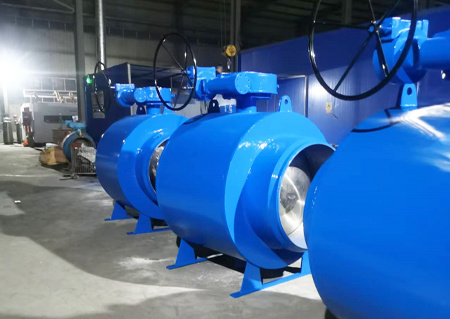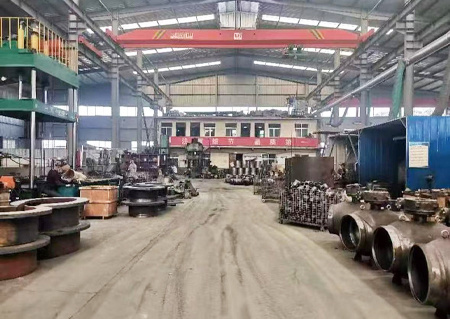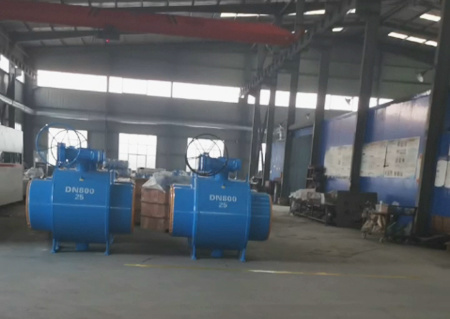Product classification

Mobile: +8618624918289
E-mail: 290004946@qq.com
Address: Xingyang Gaoshan Town Valve Industrial Park
Flanged welded ball valve 2024
The Q41F-16C flange welded ball valve is a type of ball valve that uses flange connections and welding processes to integrate the valve body (including key components such as the valve body, ball, and seat) into a single unit.
Flanged welded ball valve 2024
Flanged welded ball valve
A flanged welded ball valve is a type of industrial valve used to control the flow of liquids or gases in a piping system. It consists of a spherical ball with a hole in the middle that can be rotated to allow or block the flow of fluid. This type of valve is commonly used in industries such as oil and gas, chemical processing, and water treatment due to its reliable performance and durability.
The flanged welded ball valve is designed to withstand high temperatures and pressures, making it suitable for a wide range of applications. It is typically made of stainless steel, carbon steel, or other materials that are resistant to corrosion and erosion. The flanged ends of the valve allow it to be easily connected to the piping system using bolts and nuts, providing a secure and leak-proof seal.
One of the key features of the flanged welded ball valve is its quarter-turn operation, which allows for quick and easy opening and closing of the valve. This can be especially useful in situations where rapid flow control is required, such as in emergency shutdowns or process changes. The ball inside the valve is typically made of a hard material such as stainless steel or ceramic, which ensures a tight seal and prevents leakage.
In addition to its reliable performance, the flanged welded ball valve is also known for its low maintenance requirements. The simple design of the valve minimizes the risk of mechanical failure, reducing the need for costly repairs or replacements. Regular inspection and lubrication of the valve can help ensure its continued operation and extend its lifespan.
When selecting a flanged welded ball valve for a specific application, it is important to consider factors such as the size of the valve, the material of construction, the pressure rating, and the temperature range. Proper installation and maintenance of the valve are also crucial to ensure its optimal performance and longevity. Working with a reputable valve supplier can help ensure that you get the right valve for your needs and receive expert support throughout the lifecycle of the valve.
In conclusion, the flanged welded ball valve is a versatile and reliable valve that is widely used in industrial applications. Its robust construction, quarter-turn operation, and low maintenance requirements make it an ideal choice for controlling the flow of fluids in a piping system. By understanding the key features and benefits of the flanged welded ball valve, you can make an informed decision when selecting a valve for your specific application.
Plant






Application areas

oil and gas

Chemical industry

Food and beverage

Steam industry

Shipbuilding and Mining

Other industries
Honor

FAQ

1. Before installation, check whether the specifications, pressure, temperature, and corrosion resistance of the butterfly valve meet the usage requirements. Inspect all parts for damage or looseness.
2. This butterfly valve can be installed on pipes at any angle, preferably in a closed position; when welding the pipe flange, cover the valve sealing surface with a plate to prevent particles and debris from damaging the sealing surface. After welding, remove the valve, clean the sealing surface and the inner cavity of the pipe, and then install and secure the valve.
3. During installation, pay attention to the pressure direction when the valve is in the closed state.
4. Before installation, thoroughly clean the sealing surfaces (both ends, butterfly plate sealing surface, and valve seat sealing surface) to remove dust and dirt.
5. Before installation, perform a trial operation of the butterfly valve; it should open and close smoothly, and the open/close position should match the pointer position. Manual operation: clockwise to close, counterclockwise to open; do not apply additional force once the pointer is in position.
7. When conducting pressure tests on the valve, do not use a single flange for installation and pressure testing; double flanges must be used. When tightening bolts, do so in a symmetrical and alternating manner; do not tighten them sequentially. 9. The limit bolts have been adjusted before leaving the factory and should not be easily adjusted. If the drive device is electric or pneumatic, please read the accompanying drive device manual.
10. If the valve opens and closes abnormally, investigate the cause for repair and elimination; do not use force to operate the valve, as this may cause damage. 11. If the valve malfunction cannot be resolved, please notify our company for product installation, usage, and after-sales service.

If there are no other special requirements for the valve, it can be ordered according to the valve's number. This requires the user to understand the valve number description when ordering the product. Although this may be difficult for the user, selecting the appropriate number based on the parameters of the product they need can ensure that the provided valve fully meets the user's requirements.

1. When storing, the valve passage at both ends must be blocked with cover plates. It should be stored indoors in a dry and ventilated environment, and should be regularly checked and cleaned of dirt. Anti-rust oil should be applied to exposed machined surfaces to prevent rust.
2. Valves must be stored in a dry room and should not be placed outside to avoid damage.
3. Before transportation, valves must be tested and debugged according to the requirements of the contract or standard requirements to prevent user misoperation. For pneumatic or electric ball valves, the power source requirements for the corresponding devices must be listed according to the instructions of the pneumatic or electric device. If the user needs testing and inspection, it must be conducted according to standard requirements to prevent the product from failing to meet its performance due to incorrect testing methods. After pressure testing, any accumulated water inside the valve must be cleaned out before storage.
4. When installing the valve, the cover plates at both ends of the valve must be removed. For valves connected by welding, protective measures must be taken during the welding installation process to prevent adverse effects on the valve due to high temperatures. 5. For valves with a specific installation direction, directional arrows must be marked on the valve body to prevent incorrect installation.

1. Manual valve: When the handle is in a parallel position to the pipeline, the valve is in the open position; when it is at 90 degrees, the valve is in the closed position. Turning the handle clockwise closes the valve, while turning it counterclockwise opens the valve.
2. Worm gear driven valve: Identify using the indicator device installed on the upper part of the valve; turning the handle clockwise closes the valve, while turning it counterclockwise opens the valve. 3. Valves operated by pneumatic, electric, gas-liquid linkage, or hydraulic linkage: Operate according to the relevant actuator manual.
Key words:
Flanged welded ball valve 2024
Free Quote
Note: If you have any suggestions, please leave a message or send an email to us, and we will reply to you within 1 working day after receiving the message email.
Related Products



